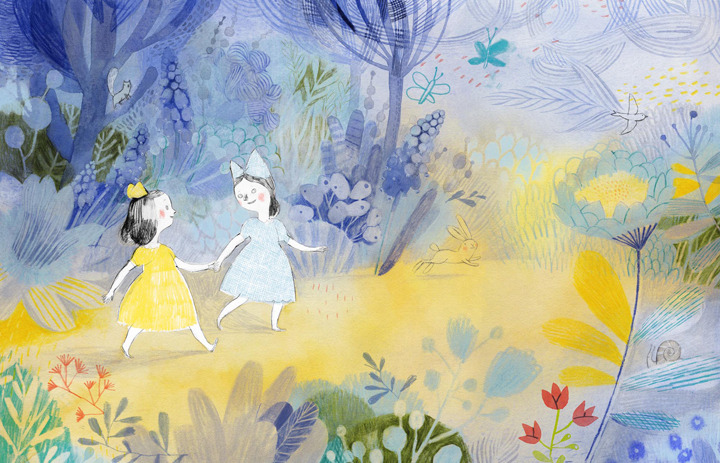How did you become a children’s book illustrator?
After I graduated with a graphic design degree, I had assignments as an editorial illustrator for magazines and newspapers from around North America. Then I had my two children, and decided to leave the editorial field and focus on children’s books. I have been drawing children’s books for five years now.
What do you enjoy about illustrating books for children?
I enjoy my freedom to do whatever I have in mind without any constraints or requests from an art director. Also, I like working on long-term projects rather than day-to-day drawings that are due on short notice. For magazines, I would only illustrate a specific topic. Now I get to draw the whole story, based on my vision. I feel more like an artist than an illustrator.
How does your relationship with Virginia Wolf’s writer, Kyo Maclear, affect your artistic freedom?
Kyo is an artist herself, so she visualizes her stories. But she is also able to give full freedom to my ideas. When I first read the Virginia Wolf manuscript, I was shocked, because I felt like I could have written the story myself. I later found out Kyo was inspired by my artwork while writing it. After we had published [our 2010 book] Spork together, she wanted to work with me again, so this script was custom-made for me.
What aspects of your past work inspired Virginia Wolf?
I think my editors and writers see something in me that can be dark or mysterious or Victorian. Some years ago, I illustrated a collection of Emily Dickinson poems. And I’ve just illustrated a book based on Jane Eyre. I am attracted to deeper work, not to bright, funny or commercial art. I feel I’m much more underground than mainstream.
An underground children’s book illustrator—can you describe your style?
I usually begin with pencil and charcoal and black ink, and for the colour parts I work with gouache and watercolours. But I create illustrations based on how each story inspires me. I like bringing the text to another level through its visuals. It’s a way to create images that can be appreciated by the eyes, but also by the brain.
What does the winning the Governor General’s Literary Award mean to you?
Well, this is a huge honor for an illustrator. It’s surprising to me, and it impresses me a lot. I’m glad that it’s not only mainstream, bright books that tend to be appreciated. It pushes me to go forward.
What’s your artistic process, from reading the story to making an illustration?
I read the story over and over again till I can see every page in my head. It’s almost like a movie. I divide the story into page breaks, then I begin to sketch. I express every part of the story till it becomes a little world. And I like to have a punch at the end of the story, to surprise the reader.
What was the punch in Virginia Wolf?
All the way through the book, you don’t see Virginia very well, you see a silhouette of a girl. But you can see that she has wolf ears. At the end of the book, when she becomes happier, you see that the wolf ears have transformed into a pretty bow.
Where did you get your inspiration for this project?
The story itself was inspiring. I really fell in love with it. My heart was beating very fast when I first read it. I felt so thankful to Kyo. And of course I researched Virginia Woolf and her sister Vanessa Bell. Pictures of them, and of their house, garden, and yard, inspired my drawings.
Virginia Woolf was rather unhappy, and the book features a little girl who is feeling gloomy. How do you illustrate darkness for children?
I created the dark scenes with simple materials—pencil and ink. I didn’t want them to be too sad, so I added touches of color to represent hope. In the first pages, which show depression and sadness, I decided to use silhouettes. Sad expressions and unhappy feelings are not present to look at: the silhouettes hide them. I wanted to suggest, not describe. [As the reader,] you can interpret the feelings however you want.
Have you learned anything from your own children that affects your work?
It’s because of them that I’m a children’s book illustrator. When they were younger, I would draw with them, and I could feel the joy of drawing like a kid. They provided me the feeling of freedom that kids have when they create—and that’s very important for a children’s book illustrator.
For this book, you drew a beautiful world called Bloomsbury; it’s where Virginia can escape to feel happy again. Where is your own Bloomsbury?
I feel very happy with my family. I don’t think I want to go anywhere else—maybe some place warmer? No. I feel very happy here in Montreal, surrounded by artists. With all that’s happening in my life, I just feel blessed and lucky and happy to do what I do.
This interview has been condensed and edited for publication.




